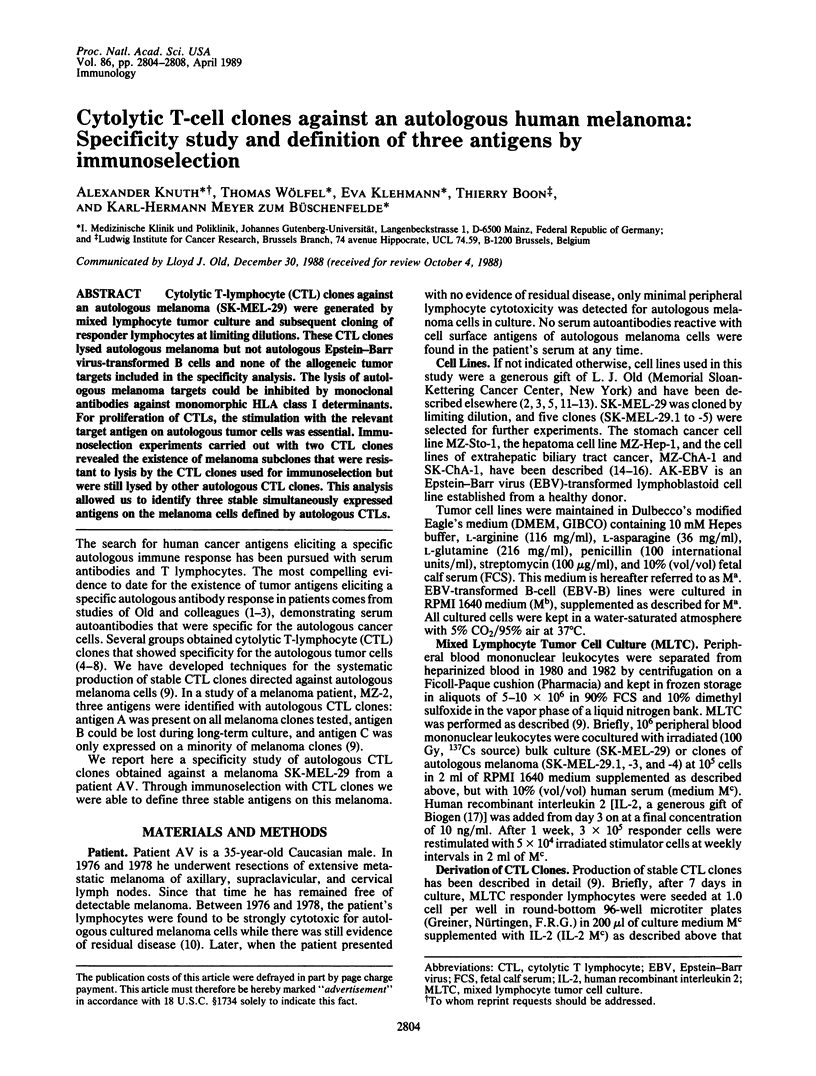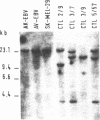Abstract
Cytolytic T-lymphocyte (CTL) clones against an autologous melanoma (SK-MEL-29) were generated by mixed lymphocyte tumor culture and subsequent cloning of responder lymphocytes at limiting dilutions. These CTL clones lysed autologous melanoma but not autologous Epstein-Barr virus-transformed B cells and none of the allogeneic tumor targets included in the specificity analysis. The lysis of autologous melanoma targets could be inhibited by monoclonal antibodies against monomorphic HLA class I determinants. For proliferation of CTLs, the stimulation with the relevant target antigen on autologous tumor cells was essential. Immunoselection experiments carried out with two CTL clones revealed the existence of melanoma subclones that were resistant to lysis by the CTL clones used for immunoselection but were still lysed by other autologous CTL clones. This analysis allowed us to identify three stable simultaneously expressed antigens on the melanoma cells defined by autologous CTLs.
Full text
PDF




Images in this article
Selected References
These references are in PubMed. This may not be the complete list of references from this article.
- Albino A. P., Lloyd K. O., Houghton A. N., Oettgen H. F., Old L. J. Heterogeneity in surface antigen and glycoprotein expression of cell lines derived from different melanoma metastases of the same patient. Implications for the study of tumor antigens. J Exp Med. 1981 Dec 1;154(6):1764–1778. doi: 10.1084/jem.154.6.1764. [DOI] [PMC free article] [PubMed] [Google Scholar]
- Anichini A., Fossati G., Parmiani G. Clonal analysis of cytotoxic T-lymphocyte response to autologous human metastatic melanoma. Int J Cancer. 1985 May 15;35(5):683–689. doi: 10.1002/ijc.2910350518. [DOI] [PubMed] [Google Scholar]
- Anichini A., Fossati G., Parmiani G. Heterogeneity of clones from a human metastatic melanoma detected by autologous cytotoxic T lymphocyte clones. J Exp Med. 1986 Jan 1;163(1):215–220. doi: 10.1084/jem.163.1.215. [DOI] [PMC free article] [PubMed] [Google Scholar]
- Barnstable C. J., Bodmer W. F., Brown G., Galfre G., Milstein C., Williams A. F., Ziegler A. Production of monoclonal antibodies to group A erythrocytes, HLA and other human cell surface antigens-new tools for genetic analysis. Cell. 1978 May;14(1):9–20. doi: 10.1016/0092-8674(78)90296-9. [DOI] [PubMed] [Google Scholar]
- Carey T. E., Takahashi T., Resnick L. A., Oettgen H. F., Old L. J. Cell surface antigens of human malignant melanoma: mixed hemadsorption assays for humoral immunity to cultured autologous melanoma cells. Proc Natl Acad Sci U S A. 1976 Sep;73(9):3278–3282. doi: 10.1073/pnas.73.9.3278. [DOI] [PMC free article] [PubMed] [Google Scholar]
- Devos R., Plaetinck G., Cheroutre H., Simons G., Degrave W., Tavernier J., Remaut E., Fiers W. Molecular cloning of human interleukin 2 cDNA and its expression in E. coli. Nucleic Acids Res. 1983 Jul 11;11(13):4307–4323. doi: 10.1093/nar/11.13.4307. [DOI] [PMC free article] [PubMed] [Google Scholar]
- Dippold W. G., Dienes H. P., Knuth A., Sachsse W., Prellwitz W., Bitter-Suermann D., Meyer zum Büschenfelde K. H. Hepatocellular carcinoma after thorotrast exposure: establishment of a new cell line (Mz-Hep-1). Hepatology. 1985 Nov-Dec;5(6):1112–1119. doi: 10.1002/hep.1840050609. [DOI] [PubMed] [Google Scholar]
- Dippold W. G., Kron G., Boosfeld E., Dienes H. P., Klingel R., Knuth A., Wagner R., Meyer Zum Büschenfelde K. H. Signet ring stomach cancer: morphological characterization and antigenic profile of a newly established cell line (Mz-Sto-1). Eur J Cancer Clin Oncol. 1987 Jun;23(6):697–706. doi: 10.1016/0277-5379(87)90265-3. [DOI] [PubMed] [Google Scholar]
- Heidmann O., Rougeon F. Multiple sequences related to a constant-region kappa light chain gene in the rabbit genome. Cell. 1982 Mar;28(3):507–513. doi: 10.1016/0092-8674(82)90205-7. [DOI] [PubMed] [Google Scholar]
- Hersey P., MacDonald M., Schibeci S., Burns C. Clonal analysis of cytotoxic T lymphocytes (CTL) against autologous melanoma. Classification based on phenotype, specificity and inhibition by monoclonal antibodies to T cell structures. Cancer Immunol Immunother. 1986;22(1):15–23. doi: 10.1007/BF00205711. [DOI] [PMC free article] [PubMed] [Google Scholar]
- Hérin M., Lemoine C., Weynants P., Vessière F., Van Pel A., Knuth A., Devos R., Boon T. Production of stable cytolytic T-cell clones directed against autologous human melanoma. Int J Cancer. 1987 Mar 15;39(3):390–396. doi: 10.1002/ijc.2910390320. [DOI] [PubMed] [Google Scholar]
- Knuth A., Danowski B., Oettgen H. F., Old L. J. T-cell-mediated cytotoxicity against autologous malignant melanoma: analysis with interleukin 2-dependent T-cell cultures. Proc Natl Acad Sci U S A. 1984 Jun;81(11):3511–3515. doi: 10.1073/pnas.81.11.3511. [DOI] [PMC free article] [PubMed] [Google Scholar]
- Knuth A., Gabbert H., Dippold W., Klein O., Sachsse W., Bitter-Suermann D., Prellwitz W., Meyer zum Büschenfelde K. H. Biliary adenocarcinoma. Characterisation of three new human tumor cell lines. J Hepatol. 1985;1(6):579–596. doi: 10.1016/s0168-8278(85)80002-7. [DOI] [PubMed] [Google Scholar]
- Lampson L. A., Levy R. Two populations of Ia-like molecules on a human B cell line. J Immunol. 1980 Jul;125(1):293–299. [PubMed] [Google Scholar]
- Livingston P. O., Shiku H., Bean M. A., Pinsky C. M., Oettgen H. F., Old L. J. Cell-mediated cytotoxicity for cultured autologous melanoma cells. Int J Cancer. 1979 Jul 15;24(1):34–44. doi: 10.1002/ijc.2910240107. [DOI] [PubMed] [Google Scholar]
- Maryanski J. L., Boon T. Immunogenic variants obtained by mutagenesis of mouse mastocytoma P815. IV. Analysis of variant-specific antigens by selection of antigen-loss variants with cytolytic T cell clones. Eur J Immunol. 1982 May;12(5):406–412. doi: 10.1002/eji.1830120509. [DOI] [PubMed] [Google Scholar]
- Mukherji B., MacAlister T. J. Clonal analysis of cytotoxic T cell response against human melanoma. J Exp Med. 1983 Jul 1;158(1):240–245. doi: 10.1084/jem.158.1.240. [DOI] [PMC free article] [PubMed] [Google Scholar]
- Old L. J. Cancer immunology: the search for specificity--G. H. A. Clowes Memorial lecture. Cancer Res. 1981 Feb;41(2):361–375. [PubMed] [Google Scholar]
- Pfreundschuh M., Shiku H., Takahashi T., Ueda R., Ransohoff J., Oettgen H. F., Old L. J. Serological analysis of cell surface antigens of malignant human brain tumors. Proc Natl Acad Sci U S A. 1978 Oct;75(10):5122–5126. doi: 10.1073/pnas.75.10.5122. [DOI] [PMC free article] [PubMed] [Google Scholar]
- Shiku H., Takahashi T., Oettgen H. F. Cell surface antigens of human malignant melanoma. II. Serological typing with immune adherence assays and definition of two new surface antigens. J Exp Med. 1976 Oct 1;144(4):873–881. doi: 10.1084/jem.144.4.873. [DOI] [PMC free article] [PubMed] [Google Scholar]
- Ueda R., Shiku H., Pfreundschuh M., Takahashi T., Li L. T., Whitmore W. F., Oettgen H. F., Old L. J. Cell surface antigens of human renal cancer defined by autologous typing. J Exp Med. 1979 Sep 19;150(3):564–579. doi: 10.1084/jem.150.3.564. [DOI] [PMC free article] [PubMed] [Google Scholar]
- Uyttenhove C., Maryanski J., Boon T. Escape of mouse mastocytoma P815 after nearly complete rejection is due to antigen-loss variants rather than immunosuppression. J Exp Med. 1983 Mar 1;157(3):1040–1052. doi: 10.1084/jem.157.3.1040. [DOI] [PMC free article] [PubMed] [Google Scholar]
- Vessière-Louveaux F., Darville M., Knuth A., Boon T. Use of irradiated mouse fibroblasts to improve the cloning and adaptation to culture of human melanoma cells. Int J Cancer. 1985 Feb 15;35(2):231–235. doi: 10.1002/ijc.2910350215. [DOI] [PubMed] [Google Scholar]
- Wortzel R. D., Philipps C., Schreiber H. Multiple tumour-specific antigens expressed on a single tumour cell. Nature. 1983 Jul 14;304(5922):165–167. doi: 10.1038/304165a0. [DOI] [PubMed] [Google Scholar]
- Yanagi Y., Yoshikai Y., Leggett K., Clark S. P., Aleksander I., Mak T. W. A human T cell-specific cDNA clone encodes a protein having extensive homology to immunoglobulin chains. Nature. 1984 Mar 8;308(5955):145–149. doi: 10.1038/308145a0. [DOI] [PubMed] [Google Scholar]
- Yoshikai Y., Anatoniou D., Clark S. P., Yanagi Y., Sangster R., Van den Elsen P., Terhorst C., Mak T. W. Sequence and expression of transcripts of the human T-cell receptor beta-chain genes. Nature. 1984 Dec 6;312(5994):521–524. doi: 10.1038/312521a0. [DOI] [PubMed] [Google Scholar]
- de Vries J. E., Spits H. Cloned human cytotoxic T lymphocyte (CTL) lines reactive with autologous melanoma cells. I. In vitro generation, isolation, and analysis to phenotype and specificity. J Immunol. 1984 Jan;132(1):510–519. [PubMed] [Google Scholar]



